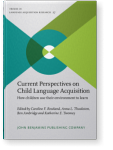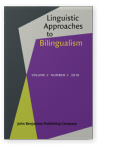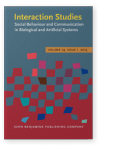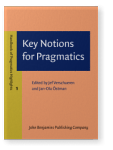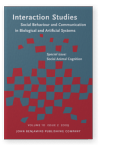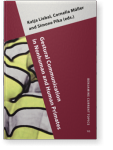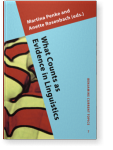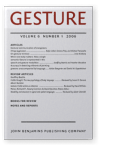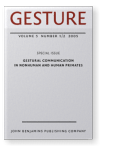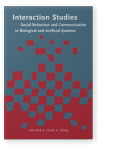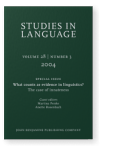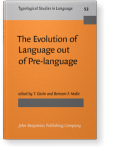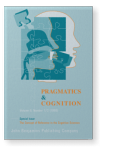Michael Tomasello
List of John Benjamins publications for which Michael Tomasello plays a role.
Book series
Journal
2020 Foreword Current Perspectives on Child Language Acquisition: How children use their environment to learn, Rowland, Caroline F., Anna L. Theakston, Ben Ambridge and Katherine E. Twomey (eds.), pp. vii–ix | Foreword
2018 Constructively combining languages: The use of code-mixing in German-English bilingual child language acquisition Linguistic Approaches to Bilingualism 8:3, pp. 393–409 | Article
Language development in bilingual children is often related to differing levels of proficiency. Objective measurements of bilingual development include for example mean length of utterance (MLU). MLU is almost always calculated for each language context (including both monolingual and code-mixed… read more
2018 Identifying partially schematic units in the code-mixing of an English and German speaking child Linguistic Approaches to Bilingualism 8:4, pp. 477–501 | Article
Intra-sentential code-mixing presents a number of puzzles for theories of bilingualism. In this paper, we examine the code-mixed English-German utterances of a young English-German-Spanish trilingual child between 1;10 – 3;1, using both an extensive diary kept by the mother and audio recordings.… read more
2013 Three-year-olds understand communicative intentions without language, gestures, or gaze Interaction Studies 14:1, pp. 62–80 | Article
The communicative interactions of very young children almost always involve language (based on conventions), gesture (based on bodily deixis or iconicity) and directed gaze. In this study, ninety-six children (3;0 years) were asked to determine the location of a hidden toy by understanding a… read more
2009 Primate communication Key Notions for Pragmatics, Verschueren, Jef and Jan-Ola Östman (eds.), pp. 208–216 | Article
2009 Breed differences in domestic dogs’ (Canis familiaris) comprehension of human communicative signals Social Animal Cognition, Matsuzawa, Tetsuro (ed.), pp. 206–224 | Article
Recent research suggests that some human-like social skills evolved in dogs (Canis familiaris) during domestication as an incidental by-product of selection for “tame” forms of behavior. It is still possible, however, that the social skills of certain dog breeds came under direct selection that… read more
2007 The gestural communication of apes Gestural Communication in Nonhuman and Human Primates, Liebal, Katja, Cornelia Müller and Simone Pika (eds.), pp. 37–51 | Article
Gestural communication of nonhuman primates may allow insight into the evolutionary scenario of human communication given the flexible use and learning of gestures as opposed to vocalizations. This paper provides an overview of the work on the gestural communication of apes with the focus on their… read more
2007 What kind of evidence could refute the UG hypothesis? Commentary on Wunderlich What Counts as Evidence in Linguistics: The case of innateness, Penke, Martina and Anette Rosenbach (eds.), pp. 175–178 | Article
2006 Gestural communication of orangutans (Pongo pygmaeus) Gesture 6:1, pp. 1–38 | Article
2005 Gestural communication of apes Gestural Communication in Nonhuman and Human Primates, Liebal, Katja, Cornelia Müller and Simone Pika (eds.), pp. 41–56 | Article
Gestural communication of nonhuman primates may allow insight into the evolutionary scenario of human communication given the flexible use and learning of gestures as opposed to vocalizations. This paper provides an overview of the work on the gestural communication of apes with the focus on their… read more
2004 To move or not to move: How apes adjust to the attentional state of others Interaction Studies 5:2, pp. 199–219 | Article
A previous observational study suggested that when faced with a partner with its back turned, chimpanzees tend to move around to the front of a non-attending partner and then gesture — rather than gesturing once to attract attention and then again to convey a specific intent. We investigated this… read more
2004 What kind of evidence could refute the UG hypothesis? Commentary on Wunderlich What Counts as Evidence in Linguistics?: The case of innateness, Penke, Martina and Anette Rosenbach (eds.), pp. 642–645 | Article
2003 Primate communication Handbook of Pragmatics: 2001 Installment, Verschueren, Jef, Jan-Ola Östman, Jan Blommaert † and Chris Bulcaen (eds.), pp. 1–11 | Article
2002 12. The emergence of grammar in early child language The Evolution of Language out of Pre-language, Givón, T. and Bertram F. Malle (eds.), pp. 309–328 | Chapter
2000 The social-pragmatic theory of word learning Pragmatics 10:4, pp. 401–413 | Article
Some researchers have tried to explain early word learning via garden-variety learning processes and others by invoking linguistically specific “constraints” that help children to narrow down the referential possibilities. The social-pragmatic approach to word learning argues that children do not… read more
1998 Communication of Food Location Between Human and Dog (Canis Familiaris) Evolution of Communication 2:1, pp. 137–159 | Article
Two domestic dogs (Canis familiaris) participated in a series of studies in which they communicated with a human about the location of hidden food. In the first study both dogs were able to follow human pointing reliably to one of several locations where food was hidden, both in front of them and… read more
1998 One child’s early talk about possession The Linguistics of Giving, Newman, John (ed.), pp. 349–374 | Article
1998 Reference: Intending that others jointly attend The Concept of Reference in the Cognitive Sciences, Kronfeld, Amichai and Lawrence D. Roberts (eds.), pp. 229–243 | Article
My approach to reference focuses on naturally occuring processes of communication, and in particular on children's earliest referential activities. I begin by describing three different kinds of child gesture — ritualizations, deictics, and symbolic gestures — and then proceed to examine young… read more
1997 The Ontogeny of Chimpanzee Gestural Signals: A Comparison Across Groups and Generations Gestural Communication in Human and Non-Human Primates, Maestripieri, Dario and Jill P. Morford (eds.), pp. 223–259 | Article
Observations of the gestural communication of two groups of captive chimpanzees are reported. For one group the observations represent a fourth longitudinal time point over a 12 year period; the other group was observed for the first time. There were two main questions. The first concerned how… read more
1991 Processes of communication in the origins of language Studies in Language Origins: Volume 2, Raffler-Engel, Walburga von, Jan Wind and Abraham Jonker (eds.), pp. 85–98 | Article


